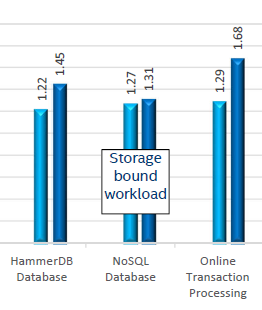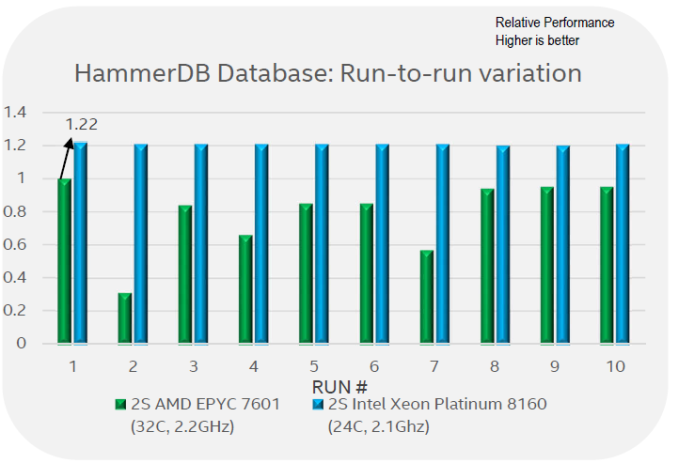Dissecting Intel's EPYC Benchmarks: Performance Through the Lens of Competitive Analysis
by Johan De Gelas & Ian Cutress on November 28, 2017 9:00 AM EST- Posted in
- CPUs
- AMD
- Intel
- Xeon
- Skylake-SP
- Xeon Platinum
- EPYC
- EPYC 7601
Database Performance & Variability
Results are very different with respect to transactional database benchmarks (HammerDB & OLTP). Intel's 8160 has an advantage of 22 to 29%, which is very similar to what we saw in our own independent benchmarking.
One of the main reasons is data locality: data is distributed over the many NUMA nodes causing extra latency for data access. Especially when data is locked, this can cause performance degradation.
Intel measured this with their own Memory Latency Checker (version 3.4), but you do not have rely on Intel alone. AMD reported similar results on the Linley Processor conference, and we saw similar results too.
There is more: Intel's engineers noticed quite a bit of performance variation between different runs.
Intel engineers claim that what they reported in the first graph on this page is, in fact, the best of 10 runs. Between the 10 runs, it is claimed there was a lot of variability: ignoring the outlier number 2, there are several occasions where performance was around 60% of the best reported value. Although we can not confirm that the performance of the EPYC system varies precisely that much, we have definitely seen more variation in our EPYC benchmarks than on a comparable Intel system.













105 Comments
View All Comments
sharath.naik - Tuesday, November 28, 2017 - link
Epyc single socket 32core/64 thread CPU is ~2000$. There is no Intel equivalent here, which is disappointing. As the single socket systems are only ~22 core max and no 205 watt parts.IGTrading - Tuesday, November 28, 2017 - link
You're talking nonsense mate :)I'd pay extra to have extra physical cores when I'm speccing a server holding VMs, but AMD gives us more cores for less money.
I also love AMD's RAID which works absolutely great and it's free while Intel's is annoyingly a paid-for solution.
Intel doesn't say one peep about Full Encrypted RAM, because they don't have it.
Intel doesn't say a pee about power consumption because their platform looses in every test.
Intel doesn't say a peep about EPYC 1.1 or EPYC Plus or whatever which will be a drop-in upgrade for the current platforms.
I was put in the shitty situation of speccing Xeon based machines because the per-core licenses were extremely expensive and the Xeon solution is offering us better performance, but other than this situation, we're doing everything to avoid working with Intel.
We still have servers that started out with dual Opterons and grew to Hexa-Core over the years.
That saved our clients a ton of money and their jaws dropped when we advised that they need to move back to Xeon if they want to upgrade (EPYC was still 2 years away then) .
It may be fashionable as a young lads to root for the "cool winner" like Ferrari, Bugatti or Intel , but when you've worked multiple decades in the industry and had to swallow all the crap Intel was pulling, you start rooting for the little guy.
ddrіver - Tuesday, November 28, 2017 - link
Paying anywhere between $12K-$50+K more per machine just to have the Intel logo tends to add up. Ending up with up to 200W more per machine also incurs some extra costs.If you said the cost fades when compared to licensing costs of many software solutions I would understand. But the metal itself... no, the extra cost for that Xeon is either stupidity or protection tax.
Geranium - Tuesday, November 28, 2017 - link
How many server software really using AVX-512? Can you give us a list (excluding AI and machine learning apps, because those ran better on GPU/Dedicate hardware).SaltyVincent - Wednesday, November 29, 2017 - link
I haven't come across in personally, but something else to add is the amount of heat these chips generate when running AVX-512 under load. Running any AVX benchmarks on Intel chips usually results in throttling.deltaFx2 - Wednesday, November 29, 2017 - link
"The whole "pricetag" thing is not really an issue": No? Is that why the volume sales in the server market is the mid-section of the former Xeon E5? Wouldn't people be buying top end E7s (Platinum in today's lingo)? Of course pricetag matters, and matters even more when you're deploying tens of thousands of nodes.Ro_Ja - Tuesday, November 28, 2017 - link
Head title needs a wee bit edit.negusp - Tuesday, November 28, 2017 - link
Your comment needs a big bit edit.Ryan Smith - Tuesday, November 28, 2017 - link
Head title? I'm not sure I follow.IGTrading - Tuesday, November 28, 2017 - link
These TSX instructions have a lot in common with AMD's own proposed ASF instructions which were discussed 3 years before TSX.Don't you think so ?